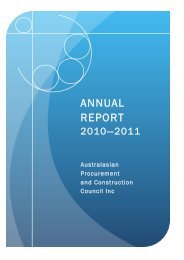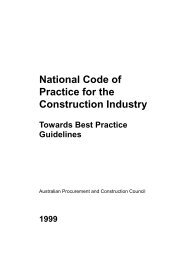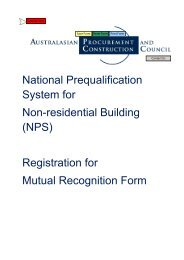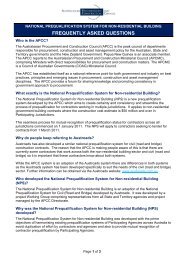Improving Security of Payment Building and Construction Industry
Improving Security of Payment Building and Construction Industry
Improving Security of Payment Building and Construction Industry
- No tags were found...
Create successful ePaper yourself
Turn your PDF publications into a flip-book with our unique Google optimized e-Paper software.
8. Insurance Page 100National Public Works Council Inc<strong>Improving</strong> <strong>Security</strong> <strong>of</strong> <strong>Payment</strong> in the <strong>Building</strong> <strong>and</strong> <strong>Construction</strong> <strong>Industry</strong>is not prohibitive.8.3 Definition <strong>of</strong> "Insurance"Insurance can be defined as a contract between the Insurer <strong>and</strong> the Insured, which takes effecton the occurrence <strong>of</strong> a nominated uncertain event (insurable event), which may or may nothappen.An insurance policy is usually taken out by a party who wishes to minimise or eliminate hisrisk <strong>of</strong> loss should that uncertain event occur. To "insure" against such an event, the partymust pay a premium to an Insurer to compensate for a potential claim against the event.Insurance is premised on the principle <strong>of</strong> utmost good faith between the Insurer <strong>and</strong> theInsured. Accordingly, full disclosure must be made by the Insured to the Insurer in relationto all relevant facts <strong>and</strong> circumstances relating to the insured event. If full disclosure is notmade the Insurer is able to avoid the insurance contract in the event <strong>of</strong> a claim.In the current context, we describe an insurance policy as a contract between an insurancecompany <strong>and</strong> the Head Contractor (the Insured) the proceeds <strong>of</strong> which are payable to thegroup <strong>of</strong> Subcontractors upon default by the Head Contractor due to its insolvency.Only those Subcontractors who have privity <strong>of</strong> contract with the Head Contractor, through ast<strong>and</strong>ard form building contract, should be able to participate within such an insurancescheme.8.4 What to InsureThe cost <strong>of</strong> insurance premiums should be significantly reduced if the potential risk <strong>of</strong> theoccurrence <strong>of</strong> insolvency <strong>and</strong> the overall financial exposure <strong>of</strong> insolvency is minimised. Webelieve by acting on the recommendations contained within this Consultancy that the riskmay be reduced to a level where the potential risk <strong>and</strong> the financial exposure <strong>of</strong> insolvencywill be minimised <strong>and</strong> hence, the cost <strong>of</strong> the premium should not be prohibitive.The effective use <strong>of</strong> the pro<strong>of</strong> <strong>of</strong> payment approaches previously mentioned combined withappropriate consensual dispute resolution mechanisms, should mean that Subcontractorsreceive progress payments on a timely basis throughout the duration <strong>of</strong> the building contract.Accordingly, a Subcontractor's exposure to non payment would be limited to two (2) aspects<strong>of</strong> financial exposure:(i) amounts due for work performed since the last progress payment; or(ii) the final progress payment.Therefore, the risk <strong>of</strong> non payment by a Head Contractor would effectively be limited to onepayment within the contract. If the recommendation for Subcontractors to receive a prioritypursuant to an amendment to Section 556 <strong>of</strong> the Corporations Law is adopted, then we wouldcontend that the financial exposure would be limited to a reduced percentage <strong>of</strong> the totalsubcontract value. This represents a substantial reduction to the risk <strong>of</strong> covering the fullsubcontract value without increasing the financial exposure <strong>of</strong> the Subcontractors.


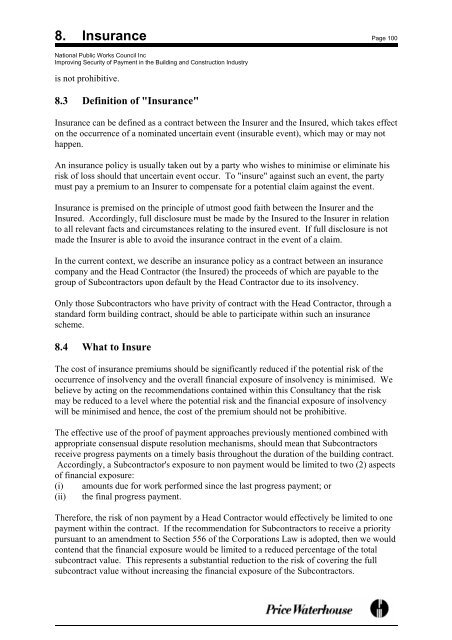
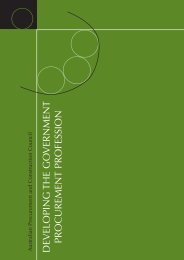
![NATIONAL COST ADJUSTMENT PROVISION EDITION 2 [NCAP2]](https://img.yumpu.com/48266135/1/184x260/national-cost-adjustment-provision-edition-2-ncap2.jpg?quality=85)



